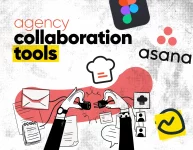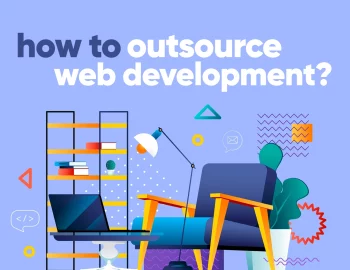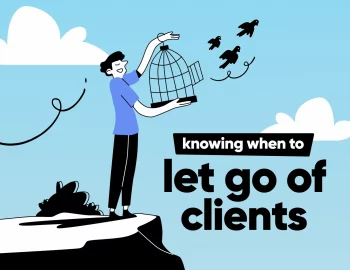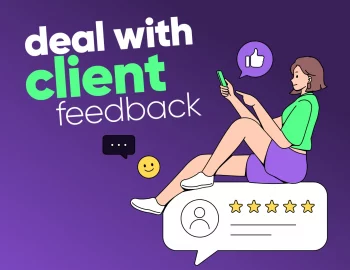Being paid timely isn’t just about peace of mind. It’s about keeping your business running smoothly. From paying employees to covering software subscriptions, a steady cash flow keeps things moving forward. And when your payment process feels polished and professional, your clients trust you more, which makes them more likely to pay on time in the first place.
Getting clients to pay on time is not about being pushy – it’s about being clear, consistent, and confident in how you work. And the best place to start? Well, let’s dive into it already.
1. Set expectations early (so no one’s surprised later)
The best way to avoid awkward payment conversations later? Lay it all out from the start.
Clear, simple terms in your proposal or welcome doc help clients know exactly what to expect, especially helpful for those who’ve never worked with a creative before.
What to include early on:
- How you bill (monthly, hourly, flat rate, milestones)
- Deposit amount and due date
- When will invoices be sent, and when are they due
- Accepted payment options
- What happens if a payment is late
Keep it simple, direct, and jargon-free. Clients appreciate clarity – it builds trust.
A 50% deposit is required to start. The remaining 50% is due upon final approval, before files are delivered. Invoices are due within 7 days. Late payments may incur a 5% fee.
Pro Tip: Providing a small early payment incentive, like 5%, for example, can motivate clients to pay invoices on time. It helps ensure a steadier cash flow while giving you more breathing room to manage the project scope with confidence (and paid bills).
2. Use contracts that work hard
A good contract isn’t just protection – it’s a tool for keeping things smooth and professional. When you’re working with small businesses or first-timers, a contract sets the tone. It shows you’re organized, serious, and looking out for both sides.
Key clauses to include:
- Project scope and deliverables
- Exact payment terms and due dates
- Timeline and what affects it
- Cancellation, refunds, and revisions
- Ownership of work (usually after full payment)
Pro Tip: Frame it as a friendly formality:
“This helps us stay on the same page and avoid surprises later.”
You can use tools like Bonsai, Fiverr Workspace, or Dubsado to make contracts easy to send, sign, and reuse (or if you just want to avoid PDF chaos).
3. Break projects into milestones (and tie payments to them)
Waiting until the end of a project to get fully paid? Risky. Creating a payment plan with milestone billing helps you get paid as you go, builds momentum, and keeps clients engaged.
Why it works:
- You’re not front-loading all the work before seeing income
- Clients feel progress and stay involved
- Payments align with delivery, so expectations are always clear
Simple billing breakdown:
- 50% deposit upfront payment
- 30% after the first major deliverable
- 20% on final approval, before file delivery
Milestones also create great check-in moments and improve the client relationship. A quick “We’ve hit phase two!” keeps things feeling collaborative, not transactional.
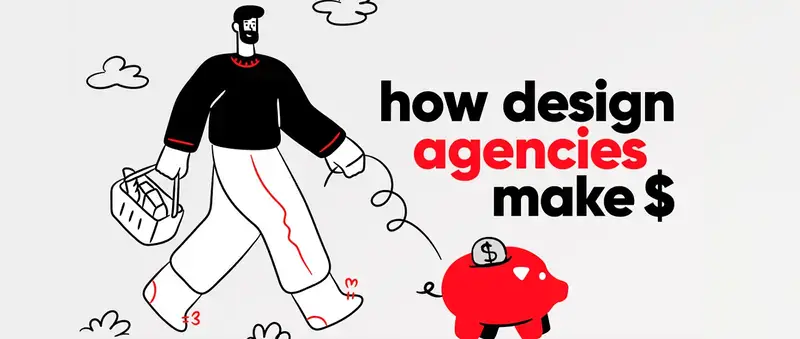
4. Deliver files the smart way (hold final delivery until paid)
One of the fastest ways to get ghosted? Sending final files before payment hits your account. Even the nicest clients can go quiet once they have what they need. So, build in a process that protects you and keeps things moving.
Tactics that work:
- Share watermarked previews or screen recordings instead of final files
- Use a staging link for websites and pause site transfers until the final payment clears
- Send a zipped folder with a password, and release the password when you have received payment
How to say it:
“Final files will be delivered once the remaining balance is received. Until then, you’ll have access to a preview link for review.”
It’s not about holding work hostage – it’s about sticking to your payment terms. And when you communicate it clearly, clients understand. Set this expectation up front (in your proposal or contract), so it never feels awkward later.
5. Automate what you can
If you’re manually sending invoices and reminders, you’re spending valuable creative time on admin work. The fix? Automation. Automated tools help you stay polite, consistent, and professional (and get paid faster) without lifting a finger every week.
What to automate:
- Invoices that are sent on a schedule
- Gentle payment reminders (before and after due dates)
- Payment confirmation emails and receipts
- Recurring billing or deposits for retainer clients
Tools to try:
- HoneyBook – All-in-one proposals, invoices, and automated workflows
- FreshBooks – Friendly invoicing and reminders with time tracking
- Wave – Free invoicing and payment tracking
- PayPal or Stripe – With integrations for automatic payments and reminders
With automation in place, you get to be the friendly, responsive professional and the one who always gets the dream on-time pay without sounding pushy to clients.
6. Send polite yet professional payment reminders
Sometimes, clients need a little nudge – not because they’re trying to dodge payment, but because life gets busy. A well-timed reminder can make all the difference.
When to follow up:
- 1-2 days before due date: Friendly heads-up
- On the invoice date: Quick reminder with invoice link
- 3-5 days past due: Polite but firmer tone
- 7+ days past due: Escalate slightly, mention payment terms
Stick to a calm, respectful tone – no guilt trips, just clarity. Consistency is key.
Bonus: 3 Invoice Reminder Templates That Sound Professional
1. Friendly Nudge – Before Due Date
Subject: Just a quick heads-up on your upcoming invoice
Hi [Client],
Hope everything’s going well! Just a quick reminder that the invoice for [Project Name] is due on [Date]. You can view and pay it here: [Link]
Let me know if you have any questions!
2. Same-Day Reminder – On Due Date
Subject: Invoice for [Project Name] – Due Today
Hi [Client],
Just popping this into your inbox as a reminder – the invoice for [Project Name] is due today. You can pay it here: [Link]
Appreciate it, and thanks again for the smooth collaboration!
3. Past Due – A Bit Firmer but Still Kind
Subject: Quick follow-up on outstanding invoice
Hi [Client],
I wanted to check in on the invoice for [Project Name], which was due on [Date]. It’s now [X] days past due.
As a reminder, late payments may incur a 5% fee as outlined in our agreement.
You can pay here: [Link]
Let me know if there’s anything you need from my side.
Tip: If you use accounting software, you can send automated reminders to encourage clients to pay according to the agreed-upon payment schedule.
7. Charge late fees (but frame it the right way)
Late fees aren’t about punishing clients, they’re about encouraging timely payment and setting clear expectations.
Most clients pay on time when they know there’s a structure in place. Mentioning additional costs for late invoices in your contract helps prevent cash flow problems more than it causes friction.
What to include in your terms:
- The fee amount (flat rate or percentage)
- When it applies (for example, 5% after 7 days late)
- A grace billing period, if you want to offer one (for example, “Payments not received within 7 days of the due date may incur a 7% late fee.”)
How to implement it gracefully:
If you have to discuss a late payment, you don’t need to lead with the penalty. A soft reminder is usually enough, but you can gently point to the terms:
“As mentioned in our agreement, there’s a small late fee for overdue payments. Let me know if you need a copy of the invoice or payment link.”
Once you’ve framed it as a standard part of your process (not a personal thing), enforcing it becomes much less awkward.
8. Make it easy for clients to pay you
Even the most willing client can delay if the payment process feels messy. The smoother it is, the faster you get paid.
Offer multiple payment options:
- Bank Transfer – good for local clients or larger invoices
- Credit Card – fast and familiar
- PayPal – easy, especially for international clients
- Stripe – clean, professional checkout experience
The key? Meet your clients where they are. Giving them options means fewer excuses and quicker payments.
How to present it clearly:
Include all payment details right on the invoice – don’t make clients hunt for info. Use a platform that embeds clickable buttons (like “Pay Now”) and labels each payment method clearly.
“You can pay via credit card, PayPal, or bank transfer using the options below. Let me know if you need help!”
And, why does it work?
The more straightforward and easy-to-understand invoice process you create, the faster clients take action. No confusion, no delays – just done.
9. Stay friendly, but keep it business
Talking about money doesn’t have to feel uncomfortable. In fact, the way you talk about it can shape how clients treat your process. The goal: friendly, clear, and confident.
Watch out for apologetic language:
Avoid phrases like:
- “Sorry to chase…”
- “I hate to bother you…”
- “Just wondering if maybe…”
Instead, go with:
“Just checking in on the invoice for [Project Name]. Let me know if you have any questions!”
It’s respectful, but still firm. You’re not chasing – you’re following up, professionally.
Why tone matters:
The way you frame money conversations sets a boundary. When you treat your work like a business, clients do too. Confidence builds trust, and trust leads to smoother payments and better working relationships.
10. Create a repeatable system you can rely on
As your studio grows, you need a process that works whether you’re managing one project or ten. When your invoice system is organized and consistent, you save time, reduce stress, and look like a total pro.
Build a simple system:
- A payment terms template you can tweak for each project
- An SOP (Standard Operating Procedure) that outlines when to invoice clients, how to follow up, and what tools you use
- A checklist that keeps everything on track – from deposit to final payment
This isn’t just admin – it’s part of your brand. Your clients will notice how smooth things feel. And you? You’ll spend way less time chasing emails and way more time doing what you love.
And what to do when clients don’t respond (and you’re owed money)?
If a client goes silent, start with a calm, step-by-step approach:
1. Resend the invoice with a friendly note
2. Follow up by a polite phone call or text if email isn’t working
3. Pause the project until late payment is resolved
If weeks go by with no response, it may be time to consider cutting ties – and in rare cases, bringing in a collection agency’s service or taking legal action. That’s a last resort, but sometimes necessary to protect your business.
Want a full guide on handling non-payment (plus more scripts)?
Check out our in-depth article here → What to Do When a Client Doesn’t Pay: Scripts, Steps & Smart Boundaries
Bottom line
Here’s the thing: asking to be paid on time isn’t awkward – it’s part of delivering great work. You’ve earned it.
Set the right payment expectations, use the right tools, and communicate clearly. This way, you turn money talk into just another part of your process – smooth, respectful, and drama-free, and that’s how you get your clients to pay you on time.
Just take the first step – start by updating your payment terms and invoice template today. It’s a small move that leads to fewer headaches and faster payments on every future project. And most importantly, it will free up time for your next amazing creation.
Interested in learning more about how to manage your creative business smoothly and keep your client relationships strong? Check out here:



![15 Tips for Effective Communication With Clients [That Actually Work]](https://reallygooddesigns.com/wp-content/uploads/2025/04/tips_for_effective_communication_with_clients-193x150.webp)


